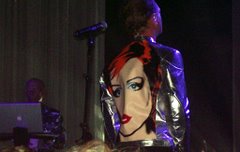The Bourne Ultimatum & Queasy-cam
 FLICK The exciting three-part action series featuring amnesiac spy Jason Bourne (Matt Damon) concludes on a high note with the tension ever mounting and Bourne learning who he is and how he got there. What makes this series kick butt is that it works on every level. It starts with a good story and characters. We’re sympathetic to Bourne not only because he is a man searching for his identity, but also because we’ve seen the human and sensitive side of the assassin – a man who has loved and lost that love. It’s not often we get to see a smart action hero with feelings.
FLICK The exciting three-part action series featuring amnesiac spy Jason Bourne (Matt Damon) concludes on a high note with the tension ever mounting and Bourne learning who he is and how he got there. What makes this series kick butt is that it works on every level. It starts with a good story and characters. We’re sympathetic to Bourne not only because he is a man searching for his identity, but also because we’ve seen the human and sensitive side of the assassin – a man who has loved and lost that love. It’s not often we get to see a smart action hero with feelings.
Damon plays Bourne with a certain amount of brooding to balance his intensity during fight scenes. We also get to see him smile briefly during his short periods with his girlfriend Maria, played by Franka Potente. The supporting cast has always been a powerhouse. Joan Allen meets her match in this installment with David Strathairn clashing on the best way to reign in Bourne. Other notables have been Brian Cox, Chris Cooper and Julia Stiles who gets in hot water but is never played as the damsel in distress. 
The suspense in the action scenes is what carries the series. It’s not only the car chases and hand-to-hand battles, but it’s the walking and being followed around the narrow streets and rooftops of cities around the world that make you want to find out what or who is lurking around the corner. (Though time is stretched a bit thin when the globetrotters are in Paris one moment and then Moscow the next, the intrigue picks right back up and it becomes a minor detail.)
While doing some movie reading at flickgrrl, the blog written by Philadelphia Inquirer’s film critic Carrie Rickey, the discussion of form following content took me to several other spots that expanded my thoughts on the film. It’s true that the rapid camera movement mirrors Bourne’s situation and agitated state, but Roger Ebert states on his website that hand-held cameras (AKA shaky-cam, queasy-cam, or whatever you call it) interacting with fast-cutting is a popular phenomenon that is not going away anytime soon. He brings up and comments on how some in the audience were getting sick from the rapid motion discussed at film theorist and author David Bordwell’s website. If you’re interested in film analysis, check out Bordwell’s article as he goes on at length about the varying styles and shot dissection within the three Bourne films.
Ebert then takes things a step further by mentioning Borwell’s experiment of sending students into a movie theater to track a film’s average shot length (ASL). (The "'vomiting point'… is apparently when a film doesn’t vary its pace, but is largely made of short hand-held shots, edited together by quick cuts that ignore spatial continuity.") He refers to cinemetrics.tv to find “the theory, measuring methods, and software” in determining ASL at home. If you really want to have a thrilling experience, extend your film fun by reading up on what makes some queasy in the theater while it’s a cinematic explosion for others. Believe me. You won't forget it. My Score (of the movie series): 9 out of 10.














